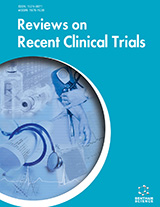Abstract
Type 2 Diabetes Mellitus (T2DM) is a chronic illness with high prevalence in Mexico, Latin- America, and the world and is associated to high morbidity, disability, and mortality rate, especially in developing countries. T2DM physiopathology is very complex; insulin resistance in the muscle, liver, and adipose tissue, a reduction in the production of incretins (mainly GLP-1) in the intestine, increased glucagon synthesis, an insufficient response of insulin generation, and increased glucose reabsorption in the kidney lead all together to an hyperglycemic state, which has been closely associated with the development of micro and macrovascular complications. Sodium Glucose Linked Transporter 2 inhibitors (SGLT2i) are the most recent therapeutic class available for treating T2DM. SGLT2i central effect is a glycosuric action, and they can reverse the deleterious effect of tubular reabsorption of glucose in the diabetic patient resulting in greater hyperglycemia. Because their mechanism of action is completely different to current drugs, they can be considered as monotherapy or in combination with any other oral or parenteral medication, including different types of insulin or its analogues. This therapeutic synergy accomplishes a greater percentage of patients achieving glycemic control goals.
Keywords: Advantages, adverse event, antidiabetic therapy, diabetes mellitus, physiopathology, SGLT2 inhibitor.
Graphical Abstract
Reviews on Recent Clinical Trials
Title:SGLT2 Inhibitors in Diabetes Mellitus Treatment
Volume: 12 Issue: 1
Author(s): Juan Rosas-Guzman, Juan Rosas-Saucedo and Alma R.J. Romero-Garcia
Affiliation:
Keywords: Advantages, adverse event, antidiabetic therapy, diabetes mellitus, physiopathology, SGLT2 inhibitor.
Abstract: Type 2 Diabetes Mellitus (T2DM) is a chronic illness with high prevalence in Mexico, Latin- America, and the world and is associated to high morbidity, disability, and mortality rate, especially in developing countries. T2DM physiopathology is very complex; insulin resistance in the muscle, liver, and adipose tissue, a reduction in the production of incretins (mainly GLP-1) in the intestine, increased glucagon synthesis, an insufficient response of insulin generation, and increased glucose reabsorption in the kidney lead all together to an hyperglycemic state, which has been closely associated with the development of micro and macrovascular complications. Sodium Glucose Linked Transporter 2 inhibitors (SGLT2i) are the most recent therapeutic class available for treating T2DM. SGLT2i central effect is a glycosuric action, and they can reverse the deleterious effect of tubular reabsorption of glucose in the diabetic patient resulting in greater hyperglycemia. Because their mechanism of action is completely different to current drugs, they can be considered as monotherapy or in combination with any other oral or parenteral medication, including different types of insulin or its analogues. This therapeutic synergy accomplishes a greater percentage of patients achieving glycemic control goals.
Export Options
About this article
Cite this article as:
Rosas-Guzman Juan, Rosas-Saucedo Juan and Romero-Garcia R.J. Alma, SGLT2 Inhibitors in Diabetes Mellitus Treatment, Reviews on Recent Clinical Trials 2017; 12 (1) . https://dx.doi.org/10.2174/1574887111666160829145810
| DOI https://dx.doi.org/10.2174/1574887111666160829145810 |
Print ISSN 1574-8871 |
| Publisher Name Bentham Science Publisher |
Online ISSN 1876-1038 |
 42
42 3
3 1
1
- Author Guidelines
- Bentham Author Support Services (BASS)
- Graphical Abstracts
- Fabricating and Stating False Information
- Research Misconduct
- Post Publication Discussions and Corrections
- Publishing Ethics and Rectitude
- Increase Visibility of Your Article
- Archiving Policies
- Peer Review Workflow
- Order Your Article Before Print
- Promote Your Article
- Manuscript Transfer Facility
- Editorial Policies
- Allegations from Whistleblowers
Related Articles
-
High Glucose Enhances Neurotoxicity and Inflammatory Cytokine Secretion by Stimulated Human Astrocytes
Current Alzheimer Research Molecular Markers of Cardiovascular Damage in Hypertension
Current Pharmaceutical Design Arachidonate Cascade in the Intensive Insulin Therapy for Critically Ill Patients with Sepsis: Roles of Prostaglandins on Hyperglycemia-Impaired Immunity
Letters in Drug Design & Discovery Biomarkers Associated with Stroke Risk in Atrial Fibrillation
Current Medicinal Chemistry High Sensitivity C-reactive Protein and Cardiovascular Risk Prediction
Current Pharmaceutical Analysis Association of Dietary Patterns with Glycated Hemoglobin <i>(HbA1c)</i> among Type 2 Diabetes Patients: A Cross-sectional Study
Current Nutrition & Food Science Overuse of PPIs in Patients at Admission, During Hospitalisation, and at Discharge in a Terciary Spanish Hospital
Current Clinical Pharmacology Medicinal Herbs Effective for Gray Hair in Traditional Persian Medicine
Current Traditional Medicine Drug Delivery to the Inner Ear: Strategies and Their Therapeutic Implications for Sensorineural Hearing Loss
Current Drug Delivery Radioprotective Effect of Pioglitazone Against Genotoxicity Induced by Ionizing Radiation in Healthy Human Lymphocytes
Cardiovascular & Hematological Agents in Medicinal Chemistry Methods of Assessment of Insulin Sensitivity and β-Cell Function
Immunology, Endocrine & Metabolic Agents in Medicinal Chemistry (Discontinued) Potential of Plant Mucilages in Pharmaceuticals and Therapy
Current Drug Delivery A Perspective on the Current Strategies for the Treatment of Obesity
Current Drug Targets - CNS & Neurological Disorders Chemical and Physical Aspects of the Edible Fractions and Seeds of Jamelao (Syzygium cumini, L. Skeels)
The Natural Products Journal Effect of Solvents, Drug/Polymer Ratio and Surfactant Concentration on In Vitro Characteristic of Repaglinide Loaded Poly (Meth) Acrylate Nanoparticles
Micro and Nanosystems Cholinesterases: Roles in the Brain During Health and Disease
Current Alzheimer Research Differential Regulation of microRNAs in Patients with Ischemic Stroke
Current Neurovascular Research Chronopharmaceutics: A Promising Drug Delivery Finding of the Last Two Decades
Recent Patents on Drug Delivery & Formulation Scutellarin Attenuates Microglia-Mediated Neuroinflammation and Promotes Astrogliosis in Cerebral Ischemia - A Therapeutic Consideration
Current Medicinal Chemistry Pioglitazone and Rosiglitazone: Effects of Treatment with a Thiazolidinedione on Lipids and Non Conventional Cardiovascular Risk Factors
Current Clinical Pharmacology


























